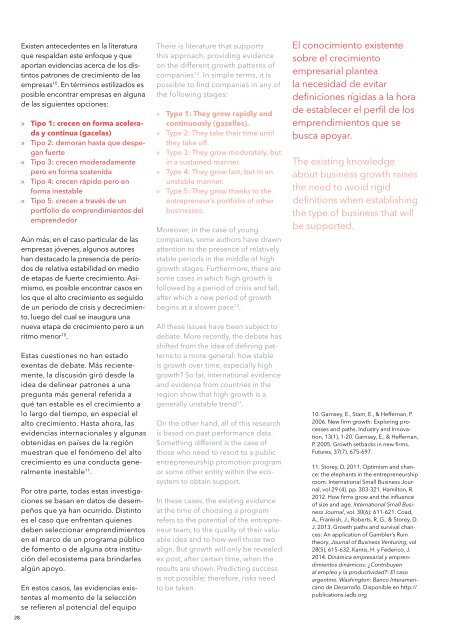Condiciones Sistémicas para el Emprendimiento Dinámico
Informe-2015-11
Informe-2015-11
Create successful ePaper yourself
Turn your PDF publications into a flip-book with our unique Google optimized e-Paper software.
28.<br />
Existen antecedentes en la literatura<br />
que respaldan este enfoque y que<br />
aportan evidencias acerca de los distintos<br />
patrones de crecimiento de las<br />
empresas 10 . En términos estilizados es<br />
posible encontrar empresas en alguna<br />
de las siguientes opciones:<br />
» Tipo 1: crecen en forma ac<strong>el</strong>erada<br />
y continua (gac<strong>el</strong>as)<br />
» Tipo 2: demoran hasta que despegan<br />
fuerte<br />
» Tipo 3: crecen moderadamente<br />
pero en forma sostenida<br />
» Tipo 4: crecen rápido pero en<br />
forma inestable<br />
» Tipo 5: crecen a través de un<br />
portfolio de emprendimientos d<strong>el</strong><br />
emprendedor<br />
Aún más, en <strong>el</strong> caso particular de las<br />
empresas jóvenes, algunos autores<br />
han destacado la presencia de períodos<br />
de r<strong>el</strong>ativa estabilidad en medio<br />
de etapas de fuerte crecimiento. Asimismo,<br />
es posible encontrar casos en<br />
los que <strong>el</strong> alto crecimiento es seguido<br />
de un período de crisis y decrecimiento,<br />
luego d<strong>el</strong> cual se inaugura una<br />
nueva etapa de crecimiento pero a un<br />
ritmo menor 10 .<br />
Estas cuestiones no han estado<br />
exentas de debate. Más recientemente,<br />
la discusión giró desde la<br />
idea de d<strong>el</strong>inear patrones a una<br />
pregunta más general referida a<br />
qué tan estable es <strong>el</strong> crecimiento a<br />
lo largo d<strong>el</strong> tiempo, en especial <strong>el</strong><br />
alto crecimiento. Hasta ahora, las<br />
evidencias internacionales y algunas<br />
obtenidas en países de la región<br />
muestran que <strong>el</strong> fenómeno d<strong>el</strong> alto<br />
crecimiento es una conducta generalmente<br />
inestable 11 .<br />
Por otra parte, todas estas investigaciones<br />
se basan en datos de desempeños<br />
que ya han ocurrido. Distinto<br />
es <strong>el</strong> caso que enfrentan quienes<br />
deben s<strong>el</strong>eccionar emprendimientos<br />
en <strong>el</strong> marco de un programa público<br />
de fomento o de alguna otra institución<br />
d<strong>el</strong> ecosistema <strong>para</strong> brindarles<br />
algún apoyo.<br />
En estos casos, las evidencias existentes<br />
al momento de la s<strong>el</strong>ección<br />
se refieren al potencial d<strong>el</strong> equipo<br />
There is literature that supports<br />
this approach, providing evidence<br />
on the different growth patterns of<br />
companies 10 . In simple terms, it is<br />
possible to find companies in any of<br />
the following stages:<br />
» Type 1: They grow rapidly and<br />
continuously (gaz<strong>el</strong>les).<br />
» Type 2: They take their time until<br />
they take off.<br />
» Type 3: They grow moderat<strong>el</strong>y, but<br />
in a sustained manner.<br />
» Type 4: They grow fast, but in an<br />
unstable manner.<br />
» Type 5: They grow thanks to the<br />
entrepreneur’s portfolio of other<br />
businesses.<br />
Moreover, in the case of young<br />
companies, some authors have drawn<br />
attention to the presence of r<strong>el</strong>ativ<strong>el</strong>y<br />
stable periods in the middle of high<br />
growth stages. Furthermore, there are<br />
some cases in which high growth is<br />
followed by a period of crisis and fall,<br />
after which a new period of growth<br />
begins at a slower pace 10 .<br />
All these issues have been subject to<br />
debate. More recently, the debate has<br />
shifted from the idea of defining patterns<br />
to a more general: how stable<br />
is growth over time, especially high<br />
growth? So far, international evidence<br />
and evidence from countries in the<br />
region show that high growth is a<br />
generally unstable trend 11 .<br />
On the other hand, all of this research<br />
is based on past performance data.<br />
Something different is the case of<br />
those who need to resort to a public<br />
entrepreneurship promotion program<br />
or some other entity within the ecosystem<br />
to obtain support.<br />
In these cases, the existing evidence<br />
at the time of choosing a program<br />
refers to the potential of the entrepreneur<br />
team, to the quality of their valuable<br />
idea and to how w<strong>el</strong>l those two<br />
align. But growth will only be revealed<br />
ex post, after certain time, when the<br />
results are shown. Predicting success<br />
is not possible; therefore, risks need<br />
to be taken.<br />
El conocimiento existente<br />
sobre <strong>el</strong> crecimiento<br />
empresarial plantea<br />
la necesidad de evitar<br />
definiciones rígidas a la hora<br />
de establecer <strong>el</strong> perfil de los<br />
emprendimientos que se<br />
busca apoyar.<br />
The existing knowledge<br />
about business growth raises<br />
the need to avoid rigid<br />
definitions when establishing<br />
the type of business that will<br />
be supported.<br />
10. Garnsey, E., Stam, E., & Heffernan, P.<br />
2006. New firm growth: Exploring processes<br />
and paths. Industry and Innovation,<br />
13(1), 1-20. Garnsey, E., & Heffernan,<br />
P. 2005. Growth setbacks in new firms.<br />
Futures, 37(7), 675-697.<br />
11. Storey, D. 2011. Optimism and chance:<br />
the <strong>el</strong>ephants in the entrepreneurship<br />
room. International Small Business Journal,<br />
vol 29 (4). pp. 303-321. Hamilton, R.<br />
2012. How firms grow and the influence<br />
of size and age. International Small Business<br />
Journal, vol. 30(6): 611-621. Coad,<br />
A., Frankish, J., Roberts, R. G., & Storey, D.<br />
J. 2013. Growth paths and survival chances:<br />
An application of Gambler’s Ruin<br />
theory. Journal of Business Venturing, vol<br />
28(5), 615-632. Kantis, H. y Federico, J.<br />
2014. Dinámica empresarial y emprendimientos<br />
dinámicos: ¿Contribuyen<br />
al empleo y la productividad?: El caso<br />
argentino. Washington: Banco Interamericano<br />
de Desarrollo. Disponible en http://<br />
publications.iadb.org


